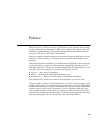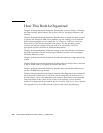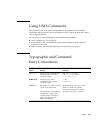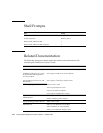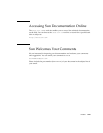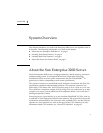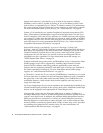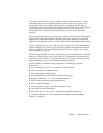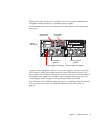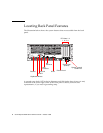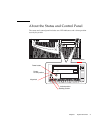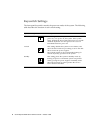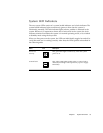
Chapter 1 System Overview 3
The system console device can be a standard ASCII character terminal or a local
windowing subsystem. The ASCII terminal connects to one of the system’s two
serial ports, while a local windowing subsystem in a graphics console requires
installation of a PCI frame buffer card, monitor, keyboard, and mouse. UPA graphics
is not supported in the Sun Enterprise 220R server. The server can also be
administered from a remote system connected to the server over an Ethernet
network.
The Sun Enterprise 220R server provides two serial communications ports through a
pair of DB-25 connectors located on the back panel. It also provides one external,
2-Mbyte per second, bidirectional, Centronics-compatible, enhanced parallel port
(EPP) for connecting the system to a local printer or other compatible parallel device.
Power is provided by one or two 380-watt power supplies with dual internal fans.
System configurations with two power supplies provide both redundancy and full
hot-swap capability. For more information about the power supplies, see “About
Power Supplies” on page 76.
The Sun Enterprise 220R server has a rackmounting kit for installation into standard
29-inch to 32-inch (73.6-cm to 81.3-cm) deep EIA 310-compliant 19-inch (48.26-cm)
wide racks, with at least four rack units (7.0 inches, 17.78 cm) of vertical mounting
space available per server, and sufficient load-bearing capacity.
System reliability, availability, and serviceability are enhanced by features
that include:
■ Error-correcting code (ECC) on memory and all data paths
■ Parity checking on all address buses
■ Front panel status indicator lights
■ Hot-pluggable internal disk drives with easy front access
■ Support for RAID 0, 1, 0 + 1, and 5 implementations
■ Power system monitoring and fault protection
■ Power supply redundancy
■ Hot-swap power supplies with easy front panel access
■ Four levels of system diagnostics
■ Easy front, top, or back access to all internal replaceable components
For additional details, see “About Reliability, Availability, and Serviceability
Features” on page 62.



